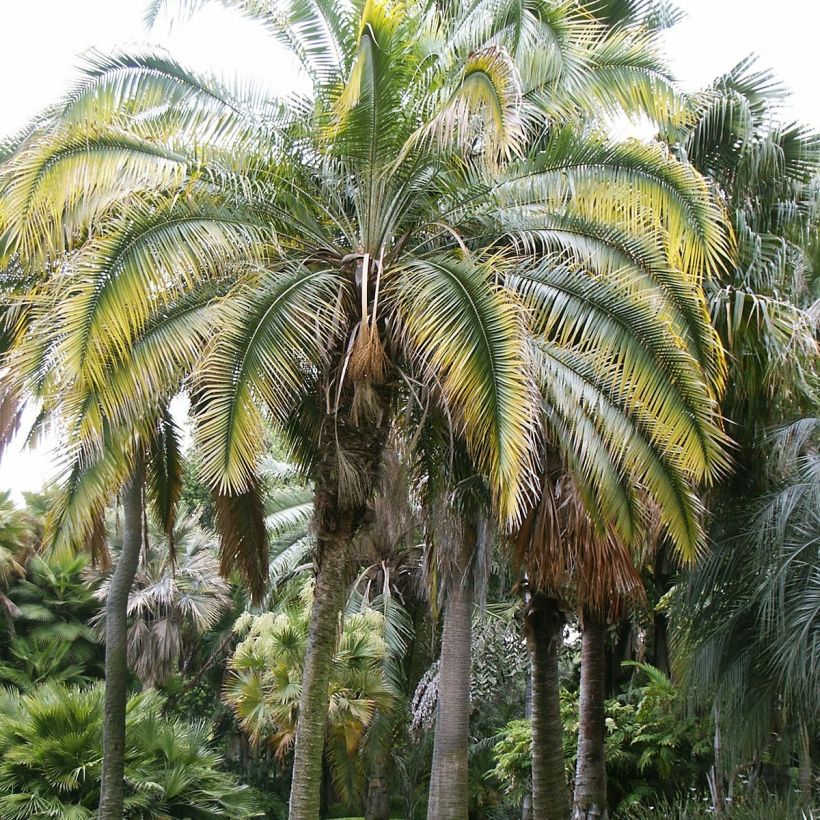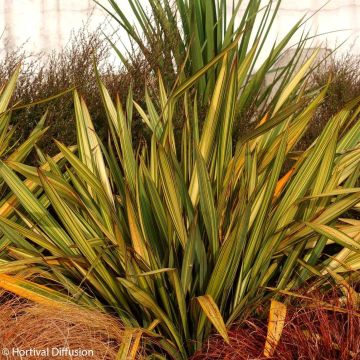

Phoenix rupicola - Palmier dattier des falaises
Phoenix roebelinii - Pygmy Date Palm
Phoenix rupicola
Cliff Date, Wild Date Palm, India Date Palm
Why not try an alternative variety in stock?
View all →This plant carries a 24 months recovery warranty
More information
We guarantee the quality of our plants for a full growing cycle, and will replace at our expense any plant that fails to recover under normal climatic and planting conditions.
From €5.90 for pickup delivery and €6.90 for home delivery
Express home delivery from €8.90.
Delivery to Corse prohibited: UE law prohibits the import of this plant from mainland France to Corse as part of the fight against Xylella fastidiosa. Please accept our sincere apologies.
More information
Does this plant fit my garden?
Set up your Plantfit profile →
Description
The Phoenix rupicola is a date palm tree native to the foothills of the Himalayas, which exotic plant collectors love for its graceful silhouette. With a slender and smooth trunk, topped with a magnificent cluster of long, shiny, vibrant green palm fronds, gracefully arched, almost feathery, forming a fountain of greenery. A magnificent landscape subject for the most sheltered gardens of the Mediterranean coast, this beautiful palm can be grown in a container or a large pot, which allows it to be protected from frost in colder regions.
The Phoenix rupicola belongs to the large family of Arecaceae. Its species name, "rupicola," which means "inhabitant of rocks," is related to its habitat: in India and Bhutan, this species grows in rocky gorges, cliffs, hills, and valleys, up to 450m (1476ft) in altitude. It is a plant adapted to a humid tropical climate and well-drained soils. The cliff date palm is a tree-like plant that generally reaches 13m (43ft) in height and 5m (16ft) in width in its natural habitat. When planted in the ground, this slow growing palm it will not exceed 8m (26ft) in height, grown in a container, it will form a lovely plant of about 2m (7ft) in height.
Its trunk, called a stipe, is solitary and brown in color, smooth, and devoid of vestiges of old petioles that are often observed on other palm trees because its dead leaves eventually detach spontaneously. It can reach a diameter of 15cm (6in). At its top, very long semi-arched leaves develop, which can measure up to 3m (10ft) in length, divided into numerous leaflets or pinnae inserted in the same plane. The foliage is a shiny dark green color, identical on the top and bottom of the leaves. Flowering occurs in summer, on mature specimens and in favorable climates, but is rare on plants grown in pots. It takes the form of inflorescences that arise between the leaves, with different appearances depending on whether they are male or female subjects. Male inflorescences are shorter than Female inflorescences which are long, pendulous, and adorned with small yellow flowers. These small flowers are followed by non-edible but decorative fruits, yellow-orange then brownish dates at maturity.
In colder regions the Phoenix rupicola is cultivated as an indoor or conservatory plant. It is a beautiful small palm tree that makes a stunning addition to a terrace during the summer and then to a conservatory in winter.
Report an error about the product description
Phoenix roebelinii - Pygmy Date Palm in pictures


Plant habit
Flowering
Foliage
Botanical data
Phoenix
rupicola
Arecaceae
Cliff Date, Wild Date Palm, India Date Palm
Himalayas
Other Phoenix
Planting and care
This Phoenix rupicola palm tree appreciates sun, heat, and well-drained but not too dry soils in summer. Planted in the ground in our mildest regions of the Mediterranean or Atlantic coast, its hardiness is very limited (-4 to -5°C (24.8 to 23°F) for short periods. Elsewhere, place it in a large pot to be able to shelter it in winter. It must be protected in case of announced cold, by tying the crown of leaves quite tightly to protect the heart of the plant. Place it in the sun, in ordinary but well-tilled, and well-drained soil. The ideal is planting in soil that retains little water but is slightly moist in summer: a balanced mixture of coarse sand, potting soil, and garden soil. It requires little maintenance except for pruning the oldest palm leaves close to the stem.
Pot cultivation:
Choose a very large pot or a perforated bottom container with a capacity of 75 to 100 liters. Prepare a mixture composed of 50% loam, 25% potting soil, 25% sand, mix well. Place a drainage layer at the bottom (clay balls, gravel, broken terracotta pots) before partially fill your container. Place your palm tree on the mixture, so that the neck (the area where the roots originate) does not exceed the pot but is not buried too deep in the substrate either. Add the rest of the mixture around the root ball, firmly compact. Water in several stages to saturate the substrate with water and remove air. Place your palm tree in a very bright place, avoiding excessive sunlight. Outdoors, initially place it in partial shade, avoiding full sun that could burn its foliage. After two weeks in partial shade, you can gradually expose it to the sun. In winter, it can be placed in a frost-free greenhouse or an unheated conservatory. Spray the foliage from time to time and reduce watering. Apply organic fertilizer or compost in spring.
Diseases and pests:
In the PACA region, where they are often planted, as well as in the south of France and Spain, large palm trees are victims of parasites such as the larvae of the widespread Paysandra archon, a large butterfly that is active up to England. Specific treatments are now available as preventive measures. The red palm weevil (Rhynchophorus ferrugineus) has been present in our territory since 2006. The symptoms are as follows: cut, dried, or yellowing palm leaves. These pests attack numerous species of palm trees, with a fatal outcome: the leaves irreversibly and completely dry out as soon as the heart of the stem hosts larvae.
Planting period
Intended location
Care
This item has not been reviewed yet - be the first to leave a review about it.
Evergreen shrubs
Haven't found what you were looking for?
Hardiness is the lowest winter temperature a plant can endure without suffering serious damage or even dying. However, hardiness is affected by location (a sheltered area, such as a patio), protection (winter cover) and soil type (hardiness is improved by well-drained soil).

Photo Sharing Terms & Conditions
In order to encourage gardeners to interact and share their experiences, Promesse de fleurs offers various media enabling content to be uploaded onto its Site - in particular via the ‘Photo sharing’ module.
The User agrees to refrain from:
- Posting any content that is illegal, prejudicial, insulting, racist, inciteful to hatred, revisionist, contrary to public decency, that infringes on privacy or on the privacy rights of third parties, in particular the publicity rights of persons and goods, intellectual property rights, or the right to privacy.
- Submitting content on behalf of a third party;
- Impersonate the identity of a third party and/or publish any personal information about a third party;
In general, the User undertakes to refrain from any unethical behaviour.
All Content (in particular text, comments, files, images, photos, videos, creative works, etc.), which may be subject to property or intellectual property rights, image or other private rights, shall remain the property of the User, subject to the limited rights granted by the terms of the licence granted by Promesse de fleurs as stated below. Users are at liberty to publish or not to publish such Content on the Site, notably via the ‘Photo Sharing’ facility, and accept that this Content shall be made public and freely accessible, notably on the Internet.
Users further acknowledge, undertake to have ,and guarantee that they hold all necessary rights and permissions to publish such material on the Site, in particular with regard to the legislation in force pertaining to any privacy, property, intellectual property, image, or contractual rights, or rights of any other nature. By publishing such Content on the Site, Users acknowledge accepting full liability as publishers of the Content within the meaning of the law, and grant Promesse de fleurs, free of charge, an inclusive, worldwide licence for the said Content for the entire duration of its publication, including all reproduction, representation, up/downloading, displaying, performing, transmission, and storage rights.
Users also grant permission for their name to be linked to the Content and accept that this link may not always be made available.
By engaging in posting material, Users consent to their Content becoming automatically accessible on the Internet, in particular on other sites and/or blogs and/or web pages of the Promesse de fleurs site, including in particular social pages and the Promesse de fleurs catalogue.
Users may secure the removal of entrusted content free of charge by issuing a simple request via our contact form.
The flowering period indicated on our website applies to countries and regions located in USDA zone 8 (France, the United Kingdom, Ireland, the Netherlands, etc.)
It will vary according to where you live:
- In zones 9 to 10 (Italy, Spain, Greece, etc.), flowering will occur about 2 to 4 weeks earlier.
- In zones 6 to 7 (Germany, Poland, Slovenia, and lower mountainous regions), flowering will be delayed by 2 to 3 weeks.
- In zone 5 (Central Europe, Scandinavia), blooming will be delayed by 3 to 5 weeks.
In temperate climates, pruning of spring-flowering shrubs (forsythia, spireas, etc.) should be done just after flowering.
Pruning of summer-flowering shrubs (Indian Lilac, Perovskia, etc.) can be done in winter or spring.
In cold regions as well as with frost-sensitive plants, avoid pruning too early when severe frosts may still occur.
The planting period indicated on our website applies to countries and regions located in USDA zone 8 (France, United Kingdom, Ireland, Netherlands).
It will vary according to where you live:
- In Mediterranean zones (Marseille, Madrid, Milan, etc.), autumn and winter are the best planting periods.
- In continental zones (Strasbourg, Munich, Vienna, etc.), delay planting by 2 to 3 weeks in spring and bring it forward by 2 to 4 weeks in autumn.
- In mountainous regions (the Alps, Pyrenees, Carpathians, etc.), it is best to plant in late spring (May-June) or late summer (August-September).
The harvesting period indicated on our website applies to countries and regions in USDA zone 8 (France, England, Ireland, the Netherlands).
In colder areas (Scandinavia, Poland, Austria...) fruit and vegetable harvests are likely to be delayed by 3-4 weeks.
In warmer areas (Italy, Spain, Greece, etc.), harvesting will probably take place earlier, depending on weather conditions.
The sowing periods indicated on our website apply to countries and regions within USDA Zone 8 (France, UK, Ireland, Netherlands).
In colder areas (Scandinavia, Poland, Austria...), delay any outdoor sowing by 3-4 weeks, or sow under glass.
In warmer climes (Italy, Spain, Greece, etc.), bring outdoor sowing forward by a few weeks.















































